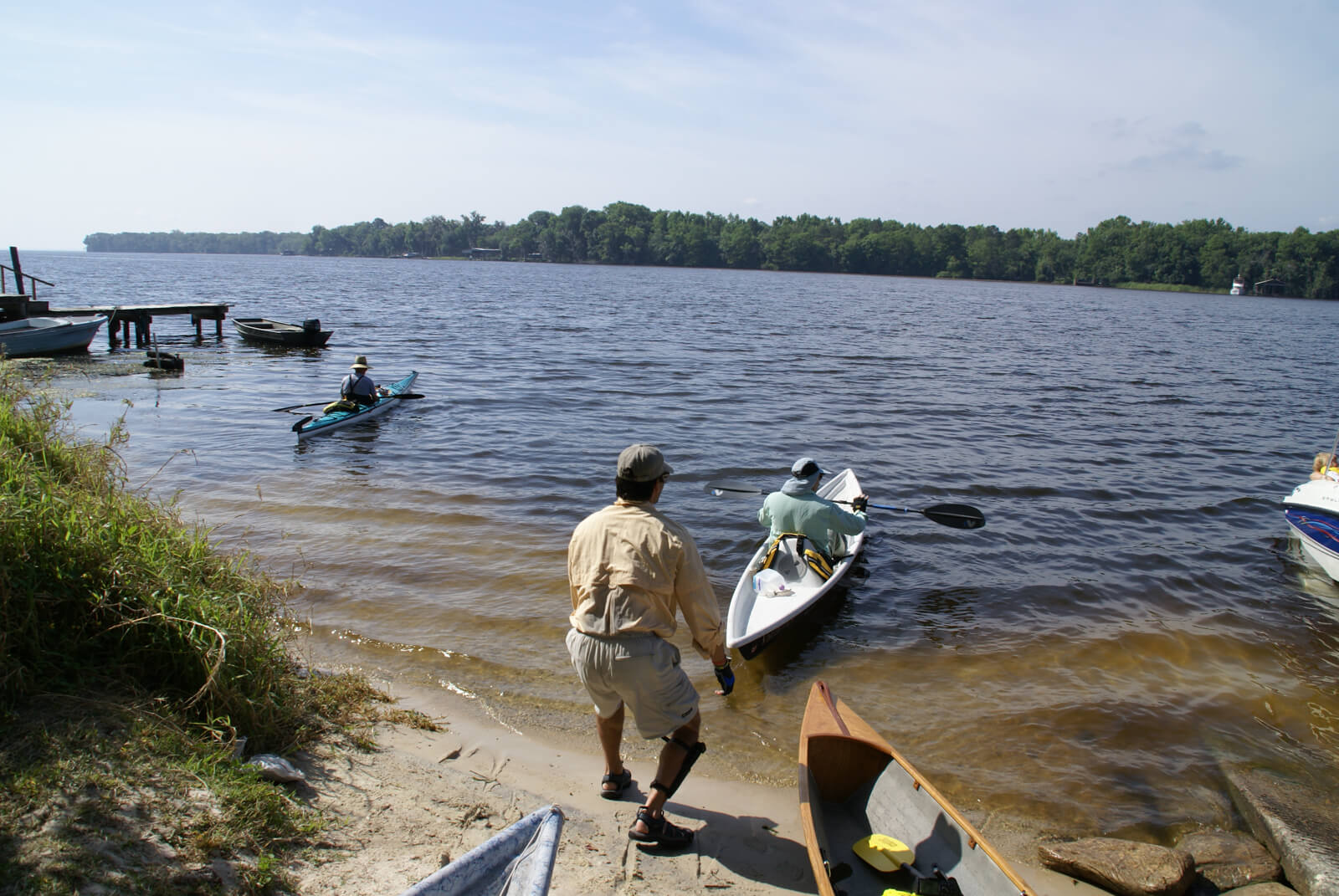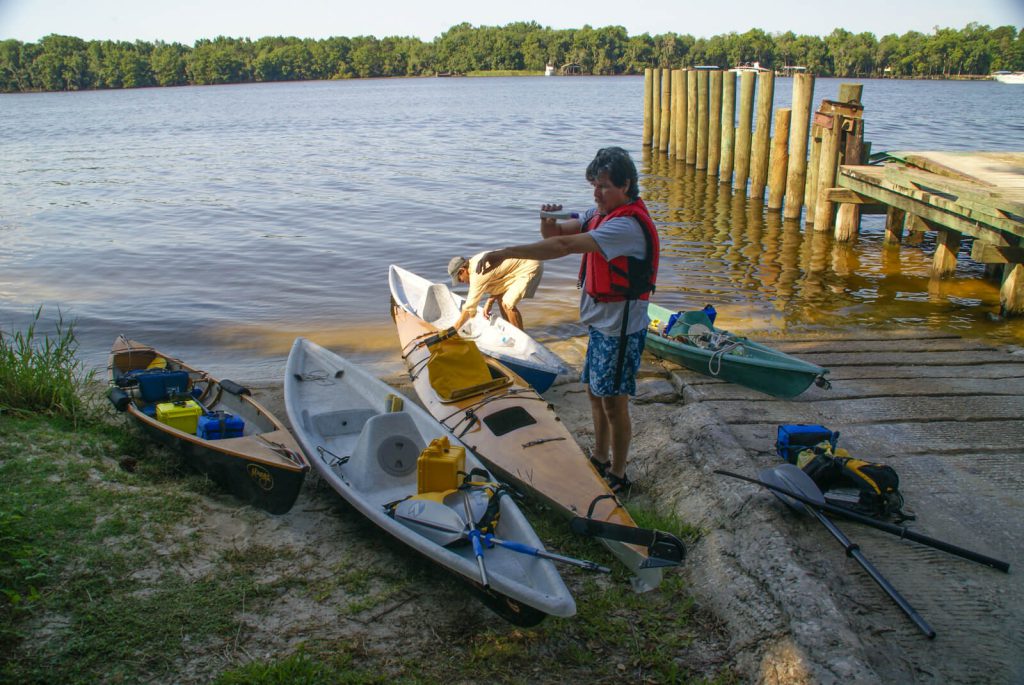23 Georgetown Camp
Putnam County


Encamped on the east-side of the river opposite to the island, from whence we heard a bear roaring in the night…
John and William Bartram
The Route
The Bartrams camped at this site on their upstream journey on the St. Johns River. On December 28, 1765, John Bartram’s party left their campsite at Johnson’s Bluff and continued up the St. Johns. They “came in a few miles” to Mount Hope, an actual distance of 2.85 miles from the bluff at Welaka Spring where they had likely camped the previous night. After exploring the Indian mound that gave this location its name, they continued up-river to Mount Royal, 4.5 miles farther south (Figure 1A). After exploring the area, they returned to their battoe and proceeded south to present-day Georgetown and set up camp opposite Drayton Island another 4 miles along the eastern shoreline.
After spending the night, they broke camp and proceeded south along the east shore but only rowed another 1.6 miles before going ashore at the north end of Lake George (Figure 1B).
The Journal describes a number of stops along the route from Spalding’s Lower Store to the Upper Store in Astor, all of which were located on the east shore of the river. This was in keeping with their desire to coast the east shore while on the southbound leg of their journey. (Figure 2). On their return voyage they coasted the west or Indian shore and used the River channel south of Drayton Island the following month. Consequently they would not have passed by this site on the return trip.
The Site
The Bartrams had already enjoyed a long and productive day of exploration having visited two impressive Indian mounds and embarked on a three mile long hike to Beecher Springs and back before arriving at their chosen campsite on December 28, 1765 (Figure 3). Despite the distance and prior activities, they apparently arrived early and with sufficient energy to continue their explorations of the lands around their camp. After setting up camp, they proceeded to hike back along the river as far as the bend where the river turns from northwest to due north (Figure 4). John cataloged the soil and vegetation in the area as well as the lay of the land with its alternating marsh, swamp and upland areas. It is possible that their hike took them fairly far inland since the Journal describes the shoreline swamps as 2 or more miles deep from the river, however this was probably a general observation rather than specific to this area. An examination of the topography in this immediate vicinity would lead one to believe that is not likely that swamplands of this depth were present at this location.
The Bartrams undoubtedly spent a restless night at this site given that they could hear the roars of a bear from their campsite. It may have been some consolation to know that the sounds came from the island across the river and not from the eastern shore where they slept.
Bartram Trail Marker 23 is mounted on a tree in the River at the northwest end of County-owned property designated, but not developed, as Biggs Park. Because the Park has not yet been developed, the marker can only be visited by water. The Marker can be easily accessed from the Drayton Island Ferry Public Boat Ramp which is located on the same shore less than one half mile east (Figure 5).
December 28, 1765 Journal Entry
“Set out from Johnson’s Bluff; foggy morning, wind N.E. thermometer 56. Came in a few miles to Mount Hope, at the entrance of a little lake, the east and south-side of which is pine-land, reaching to Johnson’s Bluff, except a point of good swamp: Mount Hope is 50 yards long and 30 wide; near 20 foot high, composed all of fresh water snail and muscle-shells of various dimensions, the small ones drove into the large, and the broken and powdered ones into the interstices of both; these are very fertile soils as far as the shells reach, and if not the only, yet the common planting grounds of the former Florida Indians, as is proved by the numerous pieces of broken Indian pots scattered all over all these shelly bluffs, and the vestiges of the corn hills still remaining, although many pretty large live oaks, red-cedars, and palms, now grow upon them: the west wind hath a long and full stroke against this mount, which perhaps raised it to that height: Saw many alligators, and killed one; ‘tis certain that both jaws open by a joint nearly alike to both: Here and near the river’s bank grows the short-poded gleditsia, elm and black-ash, with most of the South-Carolina plants[.]
“Landed at Mount-Royal, where there are 50 acres of cleared old fields, fine oranges in the woods, and a fine spring issuing out above a mile from the river, making a stream big enough to turn a mill, on the back of which the pine-lands begin: the bank and for 50 yards back is composed of sandy soil mixed with snail-shells, which for a foot or more thick is indurated to a soft rock, from which a fine south prospect opens to the great lake (the river here is above half a mile wide) near the entrance of which is a large island[.]
“Encamped on the east-side of the river opposite to the island, from whence we heard a bear roaring in the night; we lay on a low bluff of snail-shells, amongst plenty of bitter-sweet oranges, next in goodness to the China, and here the woods are full of them; we walked back over a dry kind of rich swamp full of shells mixed with black tenacious mud, under which is a white tenacious clay or marl, and in about 400 yards came to rising ground, pretty rich, and good corn-land, then to palmetto yet blackish soil, then to whitish, in which grew pines, then savannahs and ponds, which are interspersed generally in the pine-lands in most part of the southern provinces, together with the cypress and bay-swamps, and have for the most part good feeding round their borders. This rich swamp terminated at the bend of the river where the pine-land reaches close to its banks; so that the banks of this fine river are a continual alternate change of pine-land, bluffs, cypress, swamps, marshes, and rich ash, and maple-swamps: the hammocks of live-oaks and palmettos are generally surrounded either with swamp or marsh; sometimes the deep rich swamps are 2 or 3 miles deep from the river to the pines, and reach along the river from one mile to 4, 5, or 6 at uncertain depths. These swamps are supposed to be the best rice-grounds, as neither the dry weather nor wet can hurt them so much as where there is no water in dry times, and in wet there is too much, for this is rarely overflowed but in spring-tides, and these will always keep them wet enough in the dryest seasons, especially below the great lake.”
December 29, 1765 Journal Entry
“Foggy morning; thermometer 52. Landed opposite to the mouth of the lake, which hath a full stroke with a south wind; the rock is all composed of snail and muscle-shells, hard enough to build with about 4 foot thick, and will split horizontally; some parts look like limestone, but whether for want of salt that abounds in sea-shells they will make such strong lime, I cannot say. Thermometer 72. P.M. Fish jumping continually; we encamped on a rocky point near a fine swamp of 25 acres, then a marsh of 20, near the end of an island on which some pines grew, then a great rich swamp round the cove; a very rainy night welcomed us.”
Resources and Links
The Journal
Florida History Online “John Bartram’s Travels on the St. Johns River, 1765-1766.” May 2013.
http://www.unf.edu/floridahistoryonline/Projects/Bartram.html
http://www.unf.edu/floridahistoryonline/Bartram/December_1765/28dec1765.htm
http://www.unf.edu/floridahistoryonline/Bartram/December_1765/29dec1765.htm
Bartram, John. Diary of a Journey through the Carolinas, Georgia, and Florida, from July 1, 1765, to April 10, 1766, annotated by Francis Harper. Transactions of the American Philosophical Society, n.s., Vol. XXXIII, Pt. I. Philadelphia, PA, 1942.
Additional References
Florida History Online. New World in a State of Nature; British Plantations and Farms on the St. Johns River, East Florida 1763-1784. May 2013
http://www.unf.edu/floridahistoryonline/Projects/Plantations.html
Bruce, F.W. Assistant Engineer, US Army Corps of Engineers. St. Johns River to Lake Harney, Florida. 1908. The Portal to Texas History. University of North Texas. Nautical Chart of the St. Johns River.
http://texashistory.unt.edu/ark:/67531/metapth187523/m1/1/zoom/

